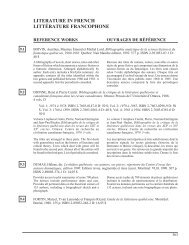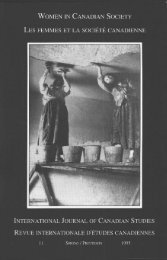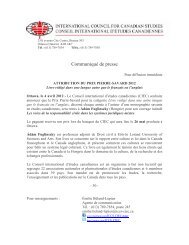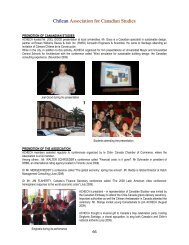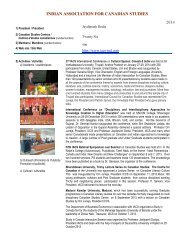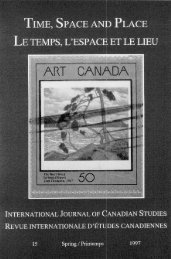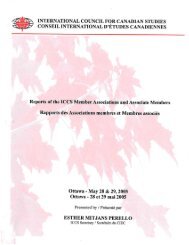Arts and Literature in Canada:Views from Abroad, Les arts et la ...
Arts and Literature in Canada:Views from Abroad, Les arts et la ...
Arts and Literature in Canada:Views from Abroad, Les arts et la ...
- No tags were found...
Create successful ePaper yourself
Turn your PDF publications into a flip-book with our unique Google optimized e-Paper software.
IJCS/RIÉCthe Kil<strong>la</strong>m-Massey House (West Vancouver, B. C., 1955). Both are variationsof the modern “g<strong>la</strong>ss box” but each is uniquely p<strong>la</strong>cebound—the former to itsdensely wooded site, the <strong>la</strong>tter to its location on a rock outcrop overlook<strong>in</strong>gHowe Sound, <strong>in</strong>dicat<strong>in</strong>g that the architect did not subscribe to the b<strong>la</strong>tantrejection of regional <strong>and</strong> cultural specificity often presumed synonymous withthe International Style. 6 Erickson turned to a very different syntax ofmodernism, that of Frank Lloyd Wright, <strong>and</strong> to Japanese architecture; bothvest the l<strong>and</strong> with great power (see Erickson, 1988, pp. 18-21, 41-44). LikeWright, he asserted that “site has to be understood before it can be enhancedwith architecture” (Erickson, 1988, p. 19). A broad def<strong>in</strong>ition of context,comprised by the tangible factors of topography, orientation, climate <strong>and</strong>surround<strong>in</strong>g structures, <strong>and</strong> the more elusive qualities of character <strong>and</strong> light,became touchstones for Erickson <strong>in</strong> diam<strong>et</strong>rical opposition to modernism'sconstruct of the build<strong>in</strong>g as a privileged, autonomous obj<strong>et</strong> d'art.By the mid-1960s, the period when he was enjoy<strong>in</strong>g great success follow<strong>in</strong>gthe compl<strong>et</strong>ion of Simon Fraser University, Erickson was not alone among thevoices that challenged an acontextual doctr<strong>in</strong>e of modernism. There is greatresonance b<strong>et</strong>ween Erickson's concern for cultural practice <strong>and</strong> the theories ofChristian Norberg-Schulz whose 1965 Intentions <strong>in</strong> Architecture counteredmodernism's rejection of tradition. “Architecture itself is a cultural object,”Norberg-Schulz (1965, pp. 122-127) stated, “only through cultural symbolismcan architecture show that the everyday has a mean<strong>in</strong>g beyond the immediatesituation <strong>and</strong> a share <strong>in</strong> the cultural <strong>and</strong> historical cont<strong>in</strong>uum.” RobertVenturi's precedent-s<strong>et</strong>t<strong>in</strong>g Complexity <strong>and</strong> Contradiction <strong>in</strong> Architecture,published the follow<strong>in</strong>g year, directly challenged the Miesian doctr<strong>in</strong>e “less ismore,” with new ways of know<strong>in</strong>g a wide spectrum of architectural traditions.True to the exhortations of Venturi's “Gentle Manifesto,” Erickson was rarely“...<strong>in</strong>timidated by the puritanically moral <strong>la</strong>nguage of orthodox modernarchitecture” (Venturi, 1966, p. 22). His Anthropology Museum speaks toVenturi's (1966, p. 22) dem<strong>and</strong>s for “elements that are hybrid rather than pure,accommodat<strong>in</strong>g rather than exclud<strong>in</strong>g” (Figure 3); so too do his Law Courts(Prov<strong>in</strong>cial Government Offices <strong>and</strong> Law Courts Complex, Robson Square,Vancouver, B. C., 1973; Figure 4) have the “messy vitality...richness ofmean<strong>in</strong>gs...<strong>and</strong> implicit function as well as explicit function,” that Venturi(1966, p. 23) sought. Perhaps most important, <strong>in</strong> the rich <strong>and</strong> purposefulcollisions of the ancient <strong>and</strong> the modern <strong>in</strong> the Anthropology Museum <strong>and</strong> itstotems (Figure 5), or the art moderne stone <strong>and</strong> the <strong>la</strong>te-modern sk<strong>in</strong> of theBank of <strong>Canada</strong> (Ottawa, Ont., 1969; Figure 6), Erickson offers what Venturi(1966, p. 23) called “a valid architecture that evokes many levels of mean<strong>in</strong>g<strong>and</strong> comb<strong>in</strong>ations of focus...its space <strong>and</strong> its elements become readable <strong>and</strong>workable <strong>in</strong> several ways at once.”Erickson's position <strong>in</strong> this progressive breakdown of the Modern Movement'santi-historicist underp<strong>in</strong>n<strong>in</strong>gs beg<strong>in</strong>s <strong>in</strong> theory <strong>and</strong> praxis that predates byalmost a decade such hallmarks of postmodern architecture as the publicationof Learn<strong>in</strong>g From Las Vegas, the 1980 Venice Biennale, <strong>and</strong> the erection of30



